CHESSBOOK REVIEWS

Latest book
reviews of 1 November 2020
Wilhelminalaan 33
7261 BP RUURLO
The Netherlands.
John
Elburg
Chess Books
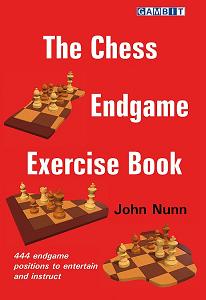
The chess endgame exercise book by John Nunn
2020
Gambit
Publications Ltd
http://www.gambitbooks.com
E-mail info@gambitbooks.com
191 pages
Price €24,30
ISBN (10
digits):1-911465-59-7
The phenomenal John Nunn comes with a brand-new high value endgame
book, based on 444 highly instructive endgame exercises.
All material is divided in difficulties and each chapter starts with
four positions all pleasantly illustrating the key ideas of play,and
where each exercise is given a difficult rating
from one up to five stars.
As John Nunn explains on YouTube
https://youtu.be/nQ5GAikuslg that some exercises are not easy to
play,the four and five start exercises would even give a grandmaster a
hard time.
Some endgame knowledge is required for a good understanding of this
book,and I am pleased to mention the Hugh amount of latest played
games,Nunn certainly does not hang in the past.
Very useful for the reader is the index of players and composers.
I am aware the endgame is the Cinderella of chess but John Nunn has
managed to create a thrilling endgame exercise book!
Conclusion:Super instructive!

600 Modern Chess
Puzzels by Martyn Kravtsiv
Gambit
Publications Ltd
http://www.gambitbooks.com
E-mail info@gambitbooks.com
191 pages
Price €23,50
ISBN (10
digits):1-911465-47-3
The well known grandmaster from Ukraine,Martyn Kravtsis who was at age
17 blitz champion at the 2008World Mind Sports Games, has managed to
create a
wonderful exercise book, where the most of these puzzles are taken from
the latest time of play.
All selected for there highly value of play, and aimed for chess
players with a wide variety of levels, lets say from beginner to close
master play.
The author explains in his introduction: If some exercises seem too
difficult for you, then don’t give up but come back to them after a
while, after the level of your play has improved.
Most exercises come from games of little known players only to make
sure that the positions will not be familiar.
Some times the reader is even asked to choose between two possibilities
,and not aware to go, for a draw or a win.
I would simple suggest play for the best possible move!
By the way chapter eleven is real nightmare, with there high difficult
level from 4 or five.
Here you will deep and outstanding ideas, all perfect for
training purposes!
For the interested reader please see the interesting describing from
John Nunn on this book:
https://youtu.be/Ffv964-Wl6M
Conclusion: There is no better way to
improve your tactical skills than with this book from Martyn
Kravtsis!
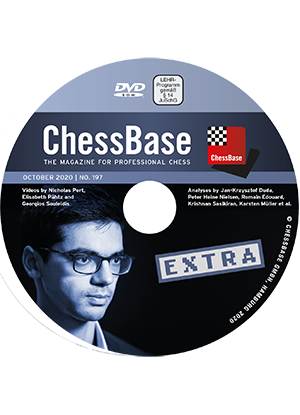
ChessBase Magazine issue 197
Extra
October 2020
ChessBase
http://www.chessbase.com
E-Mail
info@chessbase.com
ISSN 1432-8992
Euro 12,99
System requirements:
Minimum: Pentium III 1 GHz, 1 GB RAM, Windows Vista, XP
(Service Pack 3), DirectX9 graphic card with 256 MB RAM, DVD-ROM drive,
Windows Media Player 9, ChessBase 12/Fritz 13 or included Reader and
internet connection for program activation. Recommended: PC Intel Core
i7, 2.8 GHz, 4 GB RAM, Windows 8.1 or Windows 10, DirectX10 graphic
card (or compatible) with 512 MB RAM or better, 10
I have readers who buy these ChessBase Extra Magazines only for the
excellent made video files,but there is light disappointment in the so
interesting files from lisabeth Pähtz on the King’s Indian
with the move order:1.d4 Nf6 2.c4 g6 3.Nc3 Bg7 4.e4 d6 5.Be2 0-0 6.Bg5
with the surprising waiting move 6...a6. This issue
includes the first three videos from here ,but they are all only in the
German language.
A other one comes from the great Nicholas Perth on the
Nimzo-Indian and his fans will recognize his pet line with 1.d4 Nf6
2.c4 e6 3.Nc3 Bb4 4.Qc2 0-0 5.e4.
And the brilliancy contribution goes to Georgios Souleidis.
The main file of this DVD holds over the 50000 games and 23 of them are
more than excellent analysed.
A collection of the best can be found in the lucky bag,this all goes
for 28 entries,again all with excellent text analyses, as we can
see in the following game:
Duda,Jan Krzysztof (2753) - Dubov,Daniil (2699) [A37]
Lindores Abbey Prelim chess24.com INT (5.5), 20.05.2020
[Duda,Jan-Krzysztof ]
When I face Danill Dubov, I always feel an exceptional willingness to
beat him in rapid time controls. Currently I'm on a positive score,
being lucky enough to win on demand with the black pieces, and
eventually sending him home to reach the final in the GP in Hamburg. He
is a very innovative player, who has a lot of interesting thoughs and
ideas, being called as a source of inspiration for many players,
including Magnus Carlsen himself. 1.c4 A pretty reliable way of
avoiding Phillidor, Grunfeld and other unpleasant stuff 1...g6 2.Nc3 c5
3.g3 Bg7 4.Bg2 Nc6 5.Nf3 d6 6.d3 [6.0-0 is better against the e6
scheme, but I expected him to play 6...Bf5 where I wanted to have the
king on e1(6...e6 7.e3) ] 6...e6!? A good plan once White has comitted
himself to d3 (making e3-d4 senseless) 7.Bf4 In other games White
didn't achieve anything after the opening either: [7.h4 h6 8.Bd2 Nge7
9.Qc1 b6 10.0-0 Bb7 11.Rb1 (11.a3 Qd7 12.b4 Nf5 13.Rb1 g5!?) 11...Qd7
12.a3 Rc8 13.b4 Nd4 14.Nxd4 cxd4 15.Bxb7 Qxb7 16.Ne4 Qd7 17.c5 1-0 (36)
Caruana,F (2842)-Flores,D (2599) chess.com INT 2020 17...Nf5!N would
leave Black with better chances 18.Qb2 (18.g4? d5 19.gxf5 dxe4 20.fxg6
e5-+) 18...d5 19.Nd6+ Nxd6 20.cxd6 Qxd6 21.b5 Qd7³;
7.Bd2 Nge7 8.Qc1 h6 (8...0-0 9.Bh6 e5 10.h4 f6 11.Bxg7 Kxg7 12.h5 g5
13.h6+ Kh8 14.Nd2 is maybe a little something for White. 14...Be6
15.Nf1 d5 16.cxd5 Nxd5 17.Nxd5 Bxd5 18.Bxd5 Qxd5 19.f3 g4 20.Ne3 Qe6
21.Nxg4 f5 22.Ne3 Nd4 23.Nc2²; 8...Nf5) 9.0-0 looks wise, as White
has saved a move on the h4 push, but still Black is fine after many
options. 9...b6 (9...g5) 10.Rb1 Bb7 11.a3 Qd7 12.b4 Nd4 (12...g5!?;
12...Rd8) 13.Nxd4 cxd4 14.Bxb7 Qxb7 15.Ne4 Qc7?! (15...Nc8!) 16.c5!
dxc5 17.bxc5 bxc5? 18.Rb7 Qc6 19.Qxc5 Qxc5 20.Nxc5+- 1-0 (48) Zhao Jun
(2638)-Rodshtein,M (2628) chess.com INT 2020;
7.Qd2 must be too slow 7...Nge7 8.b3 d5 9.h4 h5 (9...h6!?) 10.a3 b6
11.Rb1 Bb7 12.0-0 0-0= 1-0 (38) Maghsoodloo,P (2684)-Idani,P (2570)
Teheran 2019] 7...Nge7 8.h4 [8.Qc1 h6 9.h4 is the same.] 8...h6 9.Qc1
e5 [9...b6 is another developing scheme.] 10.Bd2 I was quite happy with
having him provoked e5, thinking that I had a straightforward plan of
achieving b4, while he can't castle right now. However, the computers
(expectedly) spoiled the fun, estimating positon about -0.3 after many
moves. The truth is that by now he doesn't even need to castle, while
it's hard to oppose his plan of preparing d5 and gaining space.
10...Be6 11.Rb1 Rc8 12.a3 Frankly I don't know why I postponed
castling. Perhaps I was daydreaming of attacking him by means of h5 and
Nxg5, but this is obviously next to impossible 12...f5 [12...d5!? is
computer's favourite, when Black doesn't seem to have even a hint of
problems. 13.cxd5 a) 13.b4? cxb4 14.axb4 dxc4 15.dxc4 Bxc4-+; b) 13.b3
Qd7 (13...f5 14.h5 g5 15.Nxg5 hxg5 16.Bxg5 Qd7 17.h6 Bf8 is
unnecessarily messy.) 14.0-0 b6 15.e4 dxe4 16.dxe4 f5; 13...Nxd5
14.Nxd5 Qxd5 15.0-0 Qd7 16.b4 cxb4 17.axb4 White would be in a
comfortable spot if it weren't for 17...Nd4! 18.Qd1 Nb5 where only
Black can be better.] 13.b4 cxb4 [13...Qd7 Even this is ok according to
Stockfish.] 14.axb4 d5 15.c5 The funny thing is that at this stage I
was quite pessimistic about my position, whereas it's probably White's
best position after move 1! 15...e4 Here I was facing a dilemma,
calculating both knight retreats. In hindsight there were close to be
equally good, but very different in terms of future play. 16.Nh2
[16.Ng1 It was very tempting to have a knight on h3 rather than h2, but
I wasn't sure if the lack of one tempo would allow me to finish
development. 16...Ne5 (16...exd3? 17.Nb5 (17.Nf3!?) 17...0-0 18.Nd6 Rc7
19.Bxh6±) 17.Nh3 (17.Nb5 Nf7 Controlling d6 and allowing Black
to castle. 18.Nh3 Bd7 19.Na3 0-0 20.0-0 b6÷) 17...Qd7 18.0-0! d4
19.dxe4 dxc3 20.Bxc3 fxe4 21.Nf4© with nice compensation for the
piece.] 16...h5? Obviously he wants to castle, but giving away the
g5-square is too high a price to pay. Better was [16...Nd4 17.0-0
(17.e3 Ndc6 18.d4 0-0" with a huge storm coming on the kingside.)
17...b6 Provoking e3. 18.e3 Ndc6 19.Nb5 0-0 20.Bc3 (20.Rd1!? Ne5 21.Bf1
is perhaps a better try.) 20...Bxc3 21.Qxc3 a5 22.bxa5 bxc5 23.Qxc5
Nxa5 24.Qa3 Nac6 is a tidy bit better for White, but obviously should
be close to equality.;
16...a6 was the move I expected him to play, stopping Nb5. 17.0-0 Nd4
18.Rd1 Nec6 19.e3 Nb5 looks like Black is holding, but his positon is
quite shaky: 20.Nxb5 axb5 21.Bc3 Qe7] 17.Nb5 [17.0-0! is far better.
17...0-0 18.Rd1± and the x-ray on the d-line is challenging for
Black.] 17...0-0 18.Nd6 [18.0-0 b6 19.Qa3 was decent as well.] 18...Rc7
19.Bf4 b6 20.0-0 White is better. Black's pieces are quite passive, and
my queenside pawns combined with the help of my pieces are huge.
Obviously the g2-bishop and the h2-knight are far from great, but once
this bishop breaks out, the game will be essencially over. 20...Qd7
[20...Nd4 21.Qd2! was an important move to foresee beforehand, because
Black can't take 21...bxc5 22.bxc5 Rxc5 due to 23.Nb7+-] 21.Qd2?!
[21.Rd1 would be very strong, but I missed that after 21...Nd4 there is
22.Bf1! when White either plays e3-dxe4 or e3-d4 in a much greater
version: 22...a5 23.e3 axb4 24.exd4 Bxd4 25.Nb5+-] 21...bxc5 22.bxc5 a5
23.Rfc1 [23.Rb6!? Nc8 24.Nxc8 Rcxc8 25.Rfb1f] 23...Ra7 24.e3 Aiming to
play Bf1 and likely d4 shutting down his dark-squared bishop. Black's
position is quite bad, but his next move makes it far worse. 24...exd3?
Obviously he was relying on the a5-pawn and wanted to control the
a1-square, but now the position opens up which is bad news for Black.
[24...Nb4! was a move I expected, closing the b-file. 25.Bf1 Nc8!
(25...Nec6 26.d4±) 26.d4 (26.Be2 Nxd6 27.Bxd6 Rfa8 28.Nf1 Qe8)
26...Nxd6 27.Bxd6 Rfa8 28.Be2 Qe8 29.Nf1 Bd7 30.Ra1²] 25.Nf3! Not
even caring about the d3-pawn, my kingside pieces are back in business!
25...a4 [25...Nb4 26.Ne1 is the simplest I guess(26.Ne5 Bxe5 27.Bxe5
Nec6 28.Bc3 Kh7 is better but not yet devastating.; 26.Bf1 is also
good, but I would be reluctant to give up my light-squared bishop.) ]
26.Nb5 Rb7 27.Qxd3+- The a4-pawn is stopped, while Black's center is
collapsing. White is totally winning. 27...Ra8 28.Ng5 Rxb5 A desperate
attempt to set his asset in motion, but as explained it's over anyway.
29.Qxb5 a3 30.Bd6 a2 31.Ra1+- Calmly stopping the a2-pawn. The rest of
the game doesn't require any comments 31...Bf6 32.Qb3 Bxg5 33.hxg5 d4
34.Qb2 Kh7 35.Bxe7 Qxe7 36.Bxc6 Rc8 37.Bf3 dxe3 38.Qf6 exf2+ 39.Kxf2
Qxf6 40.gxf6 Kg8 41.c6 Rc7 42.Be2 Kf7 43.Rc5 Kxf6 44.Bc4 A nice victory
against the future winner of the tournament! 1-0
Conclusion: This is superb!
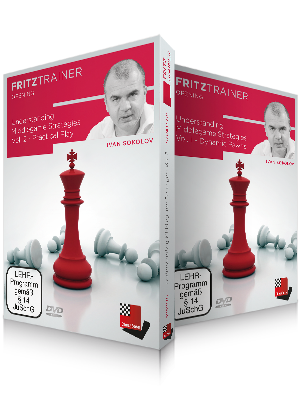
Understanding
Middlegame Strategies Vol.1 and 2
by Ivan Sokolov
2020
http://www.chessbase.com
E-Mail
info@chessbase.com
Price Euro 54.90
Windows 7 or higher
Minimum: Dual Core, 2 GB RAM, DirectX11, graphics card with 256 MB RAM,
DVD-ROM drive, Windows Media Player 9, ChessBase 14/Fritz 16 or
included Reader and internet access for program activation.
Recommended: PC Intel i5 (Quadcore), 4 GB RAM, Windows 10, DirectX11,
graphics card with 512 MB RAM or more, 100% DirectX10-compatible sound
card, Windows Media Player 11, DVD-ROM drive and internet access for
program activation.
MacOSX only available as download! Minimum: MacOS "Yosemite" 10.10
The well experienced Grandmaster Ivan Sokolov provides the user of this
video package of these two DVD’s with over eight hours highly
instructive video entertainment the secrets of chess strategies where
DVD one is based in big lines, on Minor Sacrifices, Rolling
Pawns, Pawn islands
Flank play with g- and h-pawns and more.
Included are several well explained model games to get in touch with
these so important chess strategies.
The second DVD digs a little deeper, and shows you again at the hand of
model games and more important exchange strategies.
For example what to trade and what to keep,for a beginner not a easy
task but Sokolov does it all very well.
Conclusion: Here you can feel the
touch of grandmaster play!
Highly instructive!
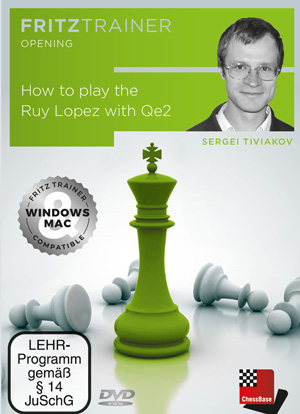
How to play the Ruy
Lopez with Qe2
by Sergei Tiviakov
2020
http://www.chessbase.com
E-Mail
info@chessbase.com
Price Euro 29.90
Windows 7 or higher
Minimum: Dual Core, 2 GB RAM, DirectX11, graphics card with 256 MB RAM,
DVD-ROM drive, Windows Media Player 9, ChessBase 14/Fritz 16 or
included Reader and internet access for program activation.
Recommended: PC Intel i5 (Quadcore), 4 GB RAM, Windows 10, DirectX11,
graphics card with 512 MB RAM or more, 100% DirectX10-compatible sound
card, Windows Media Player 11, DVD-ROM drive and internet access for
program activation.
MacOSX only available as download! Minimum: MacOS "Yosemite" 10.10
Grandmaster Sergey Tiviakov provides the user of this DVD with a
impressive over 6 hour coverage of the line 1.e4 e5 2.Nf3 Nc6 3.Bb5 Nf6
4.Qe2!
It was Andrew Greet who once wrote a interesting chapter on this move
in his book Play the Ruy Lopez,but as we can see in this DVD, Sergey
Tiviakov has a long life experience with this Worrall related
move, starting at the age of six!
It is Andrew Greet who writes: It is worth mentioning that the world’s
foremost expert on the Worrall
Tiviakov, seems to view things that way; a quick database search
reveals that he does not appear to have played anything other than
4.Qe2 against the Berlin.
White does not have to need here to much theoretical knowledge even
that there are several theoretical surveys, extra games and exercises
to see if you understood a good general understanding of the positions.
ChessBase offers us here a unique
chess DVD where the author is not afraid to throw his chess secrets
away.
Conclusion: Outstanding!
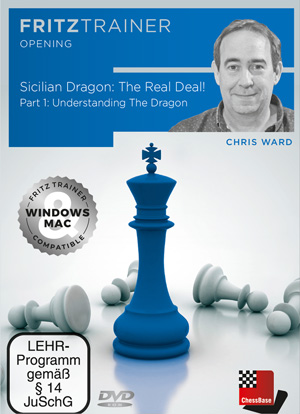
Sicilian Dragon: The
Real Deal! Part 1: Understanding The Dragon
by Chris Ward
2020
http://www.chessbase.com
E-Mail
info@chessbase.com
Price Euro 29.90
Windows 7 or higher
Minimum: Dual Core, 2 GB RAM, DirectX11, graphics card with 256 MB RAM,
DVD-ROM drive, Windows Media Player 9, ChessBase 14/Fritz 16 or
included Reader and internet access for program activation.
Recommended: PC Intel i5 (Quadcore), 4 GB RAM, Windows 10, DirectX11,
graphics card with 512 MB RAM or more, 100% DirectX10-compatible sound
card, Windows Media Player 11, DVD-ROM drive and internet access for
program activation.
MacOSX only available as download! Minimum: MacOS "Yosemite" 10.10
The famous Dragon expert Grandmaster Chris Ward does not only explain
all strategies and themes of the Dragon 1 e4 c5 2 Nf3 d6 3 d4 cxd4 4
Nxd4 Nf6 5 Nc3 g6,but also takes time to explain latest played
variations as the Chinese Variation with runs in big lines like this:
Robson,R. (2667) - Nakamura,Hi (2746) [B77]
63rd ch-USA 2019 Saint Louis USA (9.1), 29.03.2019
[Ward,Chris]
1.e4 c5 2.Nf3 d6 3.d4 cxd4 4.Nxd4 Nf6 5.Nc3 g6 6.Be3 Bg7 7.f3 0-0 8.Qd2
Nc6 9.Bc4 Bd7 10.0-0-0 Rb8 It's nice to see Hikaru persevering with the
Chinese variation and although other strong players consider it a bit
drawish if White knows what he's doing, I doubt think we can dismiss
his Super GM opponent here as being unknowledgeable! 11.Bb3 Most
flexible and common although as an indication as to how far this line
has come since its appearance, on chesspublishing we've also looked at
each of [11.h4;
11.Nxc6?!;
11.g4;
11.Nb3;
11.Nd5;
11.Kb1 and;
11.Rhe1] 11...Na5 12.Bh6 Again the most popular choice here although in
the archives (with transpositions possible), you'll also find
information on each of [12.g4;
12.Kb1;
12.Nde2?!;
and of course 12.h4 ] 12...Bxh6 13.Qxh6 b5 14.Nd5 Nxb3+ [14...e6
(Intended to force the issue with the knight and aside from that
desired affect, the outcome is that the black queen has been
transported to a good post with both attack and defence in mind. The
downside is the weakened d6-pawn.) 15.Nxf6+ Qxf6 16.h4 was the subject
of the site annotated Timofeev,A (2668)-Porat,I (2448) Ohrid MKD 2009.;
14...e5 15.Nf5!? has been well documented too and is probably worth
Black staying away from.] 15.Nxb3 e5 16.Nxf6+ [16.h4 Nxd5 17.Rxd5 Rb6
18.f4 Be6 19.h5 Qe7 20.Rd3 exf4 21.Qxf4 g5 22.Qe3 h6 also didn't seem
unreasonable for Black in Robson,R-Papp,G Lubbuck USA 2009; presumably
both players had their own thoughts on that.] 16...Qxf6 17.h4 Rb6
over-protecting the weak point d6. 18.h5 Qe7 Her majesty offers some
lateral defence along the 2nd rank but also there is the threat of
...g5 to incarcerate the white queen. 19.hxg6 [Previously only 19.Qe3
has been played with two draws.] 19...fxg6 20.Qe3 Be6 Simply improving
the bishop. Black has no problems here but I doubt either side could
have imagined what was ahead! 21.Rhf1 Structurally White is better
because of his fewer pawn islands but his knight isn't on a
particularly good track. 21...Rc6 Signalling the intent to utilise the
c-file. 22.f4?! Not especially good but having long since given up on
the h-file, clearly White wanted some activity. The '?!' then could
equally have applied to White's last move. 22...Qc7! 23.Rd2 a5 ...a4 is
the strong threat. [23...Qb6 24.Qxb6 Rxb6 would be a marginally better
endgame for Black but Nakamura wants more.] 24.Kb1 a4 [24...b4 first
equally looks tempting.] 25.Nc1 b4 26.Rdf2 [White should have tried to
mix things up through 26.f5!? gxf5 27.exf5] 26...exf4! 27.Rxf4 Rc8!
Hikaru's calculation is fantastic. 28.Rf6 Rxc2!! 29.Rxe6 [Upon 29.Qh6
Black could guard against the f8-threat through 29...Bf5! 30.exf5 a3
31.fxg6 Rxb2+ 32.Ka1 Rb1+ 33.Kxb1 Qc2+ 34.Ka1 Qb2#] 29...Qc4! Forking
both white rooks and creating further threats against the white king.
30.Ref6 a3! Mate is now threatening via .. .Rxb2+ and ...Rb1+ with of
course ...Qc2+-b2 to follow. 31.bxa3 bxa3 Again ...Rb2+-b1+ is the
mating threat. 32.Qxa3 Rxc1+! Effectively regaining the material.
33.Rxc1 [And not 33.Qxc1? Qxe4+] 33...Qxe4+ 34.Kb2 Qe5+ 35.Rc3 Rb8+!
The most accurate. 36.Kc2 [36.Ka1 Qxf6 is equally grim.] 36...Qxf6
Reaching an endgame that the superstar's technique is more than up to
converting. 37.Rf3 Qd4 38.Rb3 Qe4+ 39.Kc1 Qe1+ 40.Kc2 Qe2+ 41.Kb1 Qd1+
42.Qc1 Rxb3+ 43.axb3 Qxb3+ 44.Ka1 Qa4+ 45.Kb2 Qb5+ 46.Ka1 Qc5 47.Qd2 h5
48.Kb1 Kg7 49.Qb2+ Qe5 50.Qb7+ Kh6 51.Kc1 d5 52.Kd1 Qe4 53.Qb2 Kg5
54.Qd2+ Kg4 55.Qh6 g5 0-1.
All material is truly well explained
in a video running tine from over five hours,taking up this DVD will
help you to play and understand as no other the secrets of the Dragon
play!
Conclusion: Highly
instructive!





